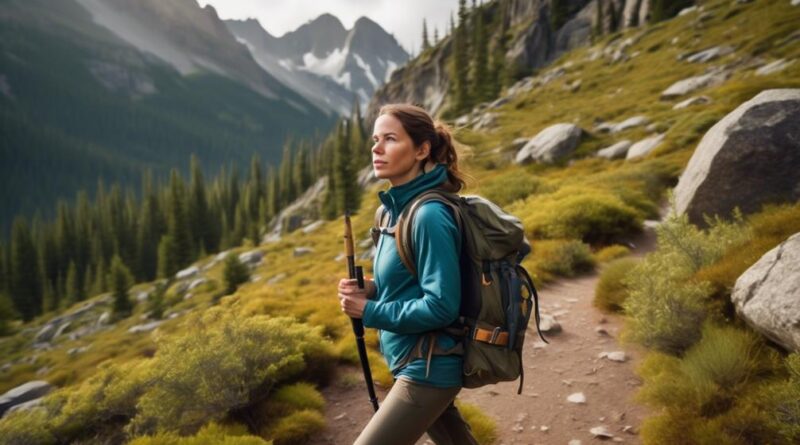Stay Safe on Remote Trails: Solo Female Hiking Tips
You may think that solo female hiking on remote trails is an impossible feat, fraught with danger at every turn. But fear not, there are ways to navigate the wilderness with confidence and security.
As you venture into the great outdoors, armed only with your backpack and determination, you'll find there are specific strategies and precautions that can help you stay safe and enjoy the solitude of nature.
So, what are these tips that can empower you to explore the trails with independence and peace of mind?
Plan Your Route Carefully
When planning your hiking route, consider the terrain, distance, and potential hazards to ensure a safe and enjoyable journey. Start by researching the trail's terrain. Will you encounter steep inclines, rocky paths, or dense vegetation? Understanding the terrain will help you pack the right gear and mentally prepare for the physical demands. Additionally, assess the distance you plan to cover. Take into account your fitness level and the time you have available. A route that's too long or challenging could lead to exhaustion or getting stranded after dark. Plotting your journey with these factors in mind will help prevent such risks.
Next, identify potential hazards along the route. Are there any dangerous wildlife species, such as bears or snakes, in the area? Knowing what to expect allows you to take necessary precautions, like carrying bear spray or wearing snake-proof boots. Additionally, be aware of weather patterns and seasonal changes that could affect the trail conditions. Sudden rain or snow can make paths slippery and more treacherous. Equipping yourself with this knowledge will help you pack suitable clothing and gear, ensuring you're prepared for any weather-related challenges.
Pack Essential Safety Gear
Ensure you pack essential safety gear, such as a first aid kit, navigation tools, and emergency communication devices, before embarking on your solo hiking adventure. These items are crucial for your safety and well-being while on remote trails.
- First Aid Kit: This is a non-negotiable item for any hiking trip. It should contain basic medical supplies such as bandages, antiseptic wipes, pain relievers, and any personal medications you may need. Be sure to familiarize yourself with the contents of your first aid kit and how to use them.
- Navigation Tools: Always carry a map, compass, or GPS device to help you stay on course. Familiarize yourself with your chosen navigation tool before setting out. Additionally, consider downloading offline maps on your smartphone as a backup.
- Emergency Communication Devices: In case of any unforeseen circumstances, having a reliable means of communication can be a lifesaver. Options include a satellite messenger, personal locator beacon (PLB), or a whistle. Ensure these devices are fully charged and easily accessible throughout your hike.
Share Your Itinerary
Consider informing a trusted friend or family member about your hiking itinerary, including the trail you plan to take, your estimated time of return, and any alternative plans you may have in case of unexpected changes. Sharing your itinerary is crucial for your safety, especially when hiking alone. If something goes wrong, having someone aware of your plans can be a lifesaver.
Provide detailed information about your planned route, such as the trailhead location, specific trails you intend to hike, and any landmarks or checkpoints along the way. Additionally, communicate your expected time of return so that if you don't check in by a certain time, your contact person can take appropriate action.
In case your plans change while you're on the trail, make sure to update your contact person. This could involve taking a different route, extending your hike, or encountering unexpected delays. By sharing alternative plans, your contact person can relay accurate information to authorities if needed.
When sharing your itinerary, ensure that your contact person understands the importance of your plans and the potential risks involved. It's also helpful to discuss a timeframe for when they should take action if they haven't heard from you.
Trust Your Instincts
Trusting your instincts is essential when hiking alone, especially if unexpected changes occur while on the trail. As a solo female hiker, it's crucial to rely on your inner voice to guide you through challenging situations and keep you safe. Here are three key points to consider when it comes to trusting your instincts:
- Recognize Warning Signs: Pay attention to any feelings of unease or discomfort, as they may be your instincts alerting you to potential danger. If something doesn't feel right, take the time to assess the situation and make the necessary adjustments to ensure your safety.
- Listen to Your Gut: Your instincts are a powerful tool for self-preservation. If you sense that a particular path or encounter may pose a risk, trust your intuition and proceed with caution. It's better to err on the side of caution than to ignore your instincts and find yourself in a precarious situation.
- Take Action: If your instincts signal a red flag, don't hesitate to take decisive action. Whether it's changing your route, seeking assistance from fellow hikers, or even turning back, trust yourself to make the best decision for your well-being.
Stay Aware of Your Surroundings
How can you actively maintain awareness of your surroundings while hiking solo? Being alert and observant is crucial for your safety on remote trails. Start by regularly scanning your environment, taking in the sights and sounds around you. Keep an eye on the trail ahead, but also glance behind you from time to time. This simple habit can help you stay aware of any changes in your surroundings, ensuring you're not caught off guard.
Additionally, consider using all your senses to stay tuned in to your surroundings. Listen for any unusual noises, as they could indicate the presence of wildlife or other hikers. Take note of any unfamiliar smells or sights as well. By being attuned to these sensory cues, you can better assess your surroundings and react to any potential risks.
It's also important to trust your gut instincts. If something feels off or out of place, don't ignore those feelings. Whether it's a strange sound or an uneasy feeling about a particular area, it's okay to alter your route or take a break until you feel comfortable moving forward. Your intuition is a powerful tool for staying safe while hiking solo.
Lastly, familiarize yourself with the trail and its landmarks before setting out. Knowing your location and the key points along the trail can help you keep track of your position and avoid getting disoriented. Stay present and engaged with your surroundings to ensure a safe and enjoyable solo hiking experience.
Practice Self-Defense Techniques
To enhance your safety while hiking solo, there are several steps you can take. First, familiarize yourself with basic self-defense techniques. Consider taking a self-defense class before hitting the trails. Being prepared and confident in your ability to defend yourself can make a significant difference in staying safe during your outdoor adventures.
Here are some essential self-defense techniques to keep in mind:
- Awareness and Prevention: Always be mindful of your surroundings and trust your instincts. Avoid isolated areas, and if you feel uncomfortable, leave the area immediately. Being aware of potential dangers can help you avoid confrontations.
- Vocal Self-Defense: Your voice can be a powerful tool for self-protection. If you sense danger, use a loud, assertive voice to communicate that you aren't an easy target. Shouting phrases like 'Back off!' or 'I don't know you, stay away!' can attract attention and deter potential attackers.
- Basic Physical Defense Moves: Learning simple physical defense techniques, such as palm strikes, elbow strikes, and knee strikes, can provide you with valuable skills to protect yourself if necessary. Practice these moves regularly to build muscle memory and confidence in your ability to defend against an assailant.
Embrace Solo Hiking Empowerment

Feeling empowered as a solo hiker begins with embracing your independence and recognizing the strength and resilience you possess. Accept that you're capable of navigating the trails on your own. Embrace the freedom that comes with solo hiking. It allows you to set your own pace, make decisions without compromise, and revel in the solitude of nature.
Empowerment also stems from being prepared. Educate yourself on trail safety, navigation, and first aid. Equip yourself with the necessary gear and knowledge to handle unexpected situations. Knowing that you're well-prepared will boost your confidence and sense of empowerment on the trails.
Furthermore, embrace the opportunity for self-discovery and personal growth that solo hiking offers. It provides a space for introspection and a chance to connect with nature in a unique way. Embracing the challenges and triumphs of solo hiking can build a sense of accomplishment and independence that translates to other areas of your life.
As a solo hiker, remember to celebrate your achievements. Each trail conquered and obstacle overcome adds to your reservoir of empowerment. Share your experiences with others, inspiring them to embrace their own solo adventures. By doing so, you contribute to a community of empowered solo hikers, fostering a sense of camaraderie and support.
Embrace the empowerment that solo hiking offers, and let it enrich your life both on and off the trails.
Frequently Asked Questions
What Are Some Strategies for Dealing With Wildlife Encounters While Hiking Alone?
If you encounter wildlife while hiking alone, stay calm and make yourself appear larger. Back away slowly without turning your back. Carry bear spray or a whistle for emergencies. Always research the area's wildlife beforehand.
How Can I Ensure My Personal Safety While Camping Alone on Remote Trails?
When camping alone on remote trails, always share your itinerary with someone, carry a personal safety device, and trust your instincts. Stay aware of your surroundings, and if something feels wrong, don't hesitate to leave.
Are There Any Specific Navigation Tools or Techniques That Are Especially Useful for Solo Female Hikers?
When hiking solo, a GPS device with offline maps can be especially useful for navigation. It helps you track your route and location. Additionally, consider carrying a compass and familiarize yourself with basic map reading skills for added safety.
What Should I Do if I Encounter Other Hikers or Individuals on the Trail Who Make Me Feel Uncomfortable or Unsafe?
If you encounter other hikers or individuals on the trail who make you feel uncomfortable or unsafe, trust your instincts. Politely and assertively create distance or change your route. Consider openly communicating with them or seeking help from other hikers.
Are There Any Specific Communication Devices or Apps That Are Recommended for Solo Female Hikers to Have in Case of Emergency?
Yes, there are specific communication devices and apps recommended for solo female hikers to have in case of emergency. Carry a satellite communicator, and download safety apps like bSafe or Noonlight for added security.
Conclusion
You've got this! With careful planning, essential gear, and a strong sense of empowerment, solo female hikers can stay safe and enjoy their time on remote trails.
Trust your instincts, stay aware of your surroundings, and practice self-defense techniques to feel confident and prepared.
Embrace the freedom and empowerment that comes with solo hiking, and remember to share your itinerary and stay safe out there!
